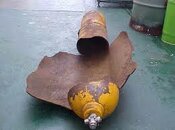TrimixToo
Contributor
Slight error in the calculation, you calculated the area of the circle using the diameter of the hole instead of the radius.
should have been
3.14(0.0625 * 0.0625) = 0.01226 sq inches
3000 / 0.01226 = 36.79 pounds pounds of thrust which is a lot less than a slowly moving light bowling ball.
Doesn't really matter though, somebody died unnecessarily and it didn't really have to happen.
Michael
Yep. Forgot to divide by two. Still plenty of thrust to make the tank spin, though.





